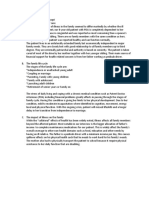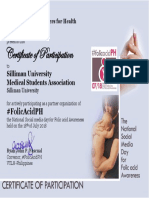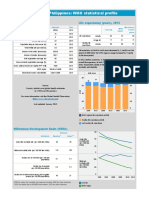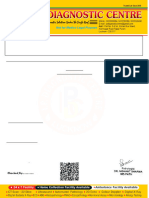Assignment - Physiology Lab Report
Uploaded by
Elizalde HusbandAssignment - Physiology Lab Report
Uploaded by
Elizalde HusbandElizale D.
Bana
1st year - Medicine
Physiology Lab Report
Dra. Ursos
1. Did you get a measurable twitch with a stimulus of 0mAh? What does this tell
you about the number of muscle fibers contracting at this stimulus current?
No muscle twitch has been observed in 0mAh. This means that there were no
muscle fibers contracting at this stimulus current.
2. What was the smallest current required to produce a contraction (the
threshold current)? What proportion of the fibers in the muscle do you think
were contracting to produce this small response?
The experiment was carried out by using the amplitudes as low as 0.00mA to
locate the twitching. But volunteer was not able to feel any twitch response
from the amplitude of 0.00mA to 4.9 mA. The threshold stimulus was
recorded at 5.0 mA. Further increasing the stimulation mA caused a larger
force of contraction by the muscle as noted by increasing amplitude of the
spikes.
3.
What was the smallest current required to produce the maximum (largest)
contraction? What proportion of the fibers in the muscle do you think were
contracting to produce maximal response?
We located the maximum contraction at 8.5mA when the force of contraction
did not increase after stimulating the muscle beyond 8.5mA, which means
that the safety factor has been reached in neuromuscular junction of
particular muscle being used.
4. What do you conclude happened to the number of fibers contracting as the
current raised from threshold to that required to produce a maximal
contraction?
Because the action potential is an all or none response, the contraction of a
muscle fiber in response to a single action potential is likewise an all or none
response. Therefore, there is a minimum stimulus strength that must be
applied to the muscle fiber in order to reach threshold, evoke the action
potential and, in turn, induce the contraction. Once the action potential
occurs, though, no further increase in stimulus strength will increase the
strength of contraction, as the Ca2+ gates in the sarcoplasmic reticulum are
open for a fixed amount of time once opened.
The action potential is evoked upon application of the stimulus. That action
potential, in turn, propagates down the length of the muscle fibers and
triggers the excitation-contraction coupling process (release of Ca2+ from the
sarcoplasmic reticulum, binding of Ca2+ to troponin, etc.). Once crossbridge
cycling ensues, the muscle fibers contract, generating tension. Tension peaks,
but then decreases as the activity of Ca2+ pumps in the sarcoplasmic
reticulum reuptake Ca2+from the cytosol, lowering the ability of actin and
myosin to form crossbridges, and reducing tension generation as the fibers
stretch back to their original length. These three basic stages (excitationcontraction coupling, tension generation, and relaxation) correlate with three
different time phases during the twitch. During the latent period (the time
between the application of the stimulus and the onset of contraction),
excitation-contraction coupling takes place. During the contraction time (the
time from the onset of contraction to peak tension), crossbridge cycling
occurs at a high enough rate that the muscle fibers shorten. During the
relaxation time (from peak tension to the point when tension returns to
baseline), Ca2+ is being pumped back into the sarcoplasmic reticulum, and
the muscle is stretching back to its original length. Since the duration of the
total relaxation time is often difficult to calculate (since it is difficult to
determine exactly when tension returns to baseline levels), researchers
commonly use an alternate measurement, the relaxation time, which is the
duration it takes for tension to drop from peak tension to of peak tension.
5. Why does varying the stimulus strength affect the twitch force?
In the experiment we noted that the strength of the contraction varies with
the strength of the stimulus applied. This does not violate the all or none
principle. Rather, as stimulus strength is being increased, progressively more
muscle fibers reach their thresholds and contract. Thus, the change in tension
is due to the number of contracting muscle fibers, not a change in how much
tension the individual fibers are generating. Note that stimuli below the
minimum strength needed to trigger any of the muscle fibers to reach
threshold and undergo an action potential (i.e., subthreshold stimuli) will not
trigger any contraction in the muscle. Threshold is considered to be the level
of stimulation required to trigger the smallest measurable contraction
resulting from the excitation and contraction of the first few muscle fibers. If
stimulus is increased above threshold into a range of stimulus intensities
called submaximal stimuli, contraction strength will increase with stimulus
intensity as progressively more and more muscle fibers in the muscle
undergo contraction. Finally, when stimulus strength is increased above a
certain level (maximal) no further increase in tension occurs, as all muscle
fibers in the muscle are contracting.
6. What are the two ways by which the nervous system can control the force
generated by a muscle?
Summation, incomplete tetanus, and complete tetanus were three features of
muscle contraction that were observed by gradually increasing the frequency
of stimulation from 2 to 5 Hz to 10 Hz to 20Hz. At 13.5, the peak of
contraction force for a single twitch was recorded. Summation was observed
in the muscle at 2.3Hz. Therefore, the 2 ways that nervous system can
control the force generated by a muscles are:
A. Increasing the number of motor units contracting simultaneously
B. Increasing the number of frequency of contraction-tetanization
7. Electromyography, with needle electrodes inserted through the skin into a
muscle, has been used to study the frequency of muscle fiber activation
during voluntary contraction in humans. During the weak contractions, the
firing frequency is low, so that each fiber produces distinct twitches. The
force produced by the whole muscle, however, is relatively smooth. How do
you think this occurs?
The prediction concluded in hypothesizing that increasing the frequency of
stimuli on the muscle would cause contractile force to summate and increase
to a maximum point without relaxation and remain there for a period of time
before slowly showing decay in force.
8. Do your experiments help to decide which factors are important?
Out of many factors that have been proposed to explain the fall in force
during fatigue, we observed that due to prolong and strong contraction the
stimulation of the nerve fiber increases rates of impulses for several minutes
followed by gradual decrease of impulses probably due to metabolic changes
in the muscles as it depletes glycogen, and interrupt blood flow owing to
compression of blood vessel, thus anaerobic respiration was observed by its
pain sensation.
9. What explanations can you think for pseudo-fatigue?
Pseudo-fatigue resembles fatigue because there is a declining force exerted
while the person's eyes are shut. Losing the sense of sight puts you at a
disadvantage because you can't read the monitor while you are exerting the
force. Also, concentration may drift to other things while your eyes are
closed.
You might also like
- Plyometrics for Athletes at All Levels: A Training Guide for Explosive Speed and PowerFrom EverandPlyometrics for Athletes at All Levels: A Training Guide for Explosive Speed and Power5/5 (1)
- Review Sheet Exercise 2 Skeletal Muscle PhysiologyNo ratings yetReview Sheet Exercise 2 Skeletal Muscle Physiology7 pages
- Physico - Chemical Aspects of Muscle Contraction Part 2No ratings yetPhysico - Chemical Aspects of Muscle Contraction Part 230 pages
- BSC 1085 Fall 2018 Lab 7 - Muscle PhysiologyNo ratings yetBSC 1085 Fall 2018 Lab 7 - Muscle Physiology2 pages
- Coordination: Physiology of Muscle Contraction and Different Muscle Contraction (Isotonic, Isometric, Isokinetic)No ratings yetCoordination: Physiology of Muscle Contraction and Different Muscle Contraction (Isotonic, Isometric, Isokinetic)6 pages
- Skeletal Muscle Practical Questions - VanessaNo ratings yetSkeletal Muscle Practical Questions - Vanessa9 pages
- Bruce Lee's How To Strengthen Your Tendons and LigamentsNo ratings yetBruce Lee's How To Strengthen Your Tendons and Ligaments6 pages
- Penuntun Praktikum Fisiologi Dermatomuskuloskeletal REV 2022 - UNTIRTANo ratings yetPenuntun Praktikum Fisiologi Dermatomuskuloskeletal REV 2022 - UNTIRTA27 pages
- Dr. Dr. Hardian - B - Rangga Eta - 22010120130088No ratings yetDr. Dr. Hardian - B - Rangga Eta - 2201012013008812 pages
- Physiology practicals (Amphibian charts)-No ratings yetPhysiology practicals (Amphibian charts)-16 pages
- Fisiologia Del Musculo Esqueletico Ejercicio 2 Cod 20120353100% (2)Fisiologia Del Musculo Esqueletico Ejercicio 2 Cod 2012035354 pages
- Lab 1: Electrical and Mechanical Properties of Skeletal MuscleNo ratings yetLab 1: Electrical and Mechanical Properties of Skeletal Muscle3 pages
- Brain Training For Runners: A Revolutionary New Training System to Improve Endurance, Speed, Health, and ResultsFrom EverandBrain Training For Runners: A Revolutionary New Training System to Improve Endurance, Speed, Health, and ResultsNo ratings yet
- Turn Pain Off: How to Alleviate Musculo-skeletal Pain Using Trigger Point Relief TechniqueFrom EverandTurn Pain Off: How to Alleviate Musculo-skeletal Pain Using Trigger Point Relief TechniqueNo ratings yet
- Patient's Name: - Age /sex: - Job: - Address: - Chief Complaint: - Associated SymptomsNo ratings yetPatient's Name: - Age /sex: - Job: - Address: - Chief Complaint: - Associated Symptoms1 page
- Phi L I Ppi Nes: WHO Stati Sti Cal Profi L E: Basi C Stati Sti Cs Li Fe Expectancy (Years), 2012No ratings yetPhi L I Ppi Nes: WHO Stati Sti Cal Profi L E: Basi C Stati Sti Cs Li Fe Expectancy (Years), 20123 pages
- Breastfeeding Basics: Positioning, Attachment, Hold Dr. Fay S. de OcampoNo ratings yetBreastfeeding Basics: Positioning, Attachment, Hold Dr. Fay S. de Ocampo10 pages
- Analysis of Data-1 Research Objectives and Data AnalysisNo ratings yetAnalysis of Data-1 Research Objectives and Data Analysis17 pages
- Pengaruh Pemberian Probiotik Lactobacillus Acidophilus Dan Bifidobacterium Terhadap Produksi Ayam Petelur Yang Diinfeksi Escherichia ColiNo ratings yetPengaruh Pemberian Probiotik Lactobacillus Acidophilus Dan Bifidobacterium Terhadap Produksi Ayam Petelur Yang Diinfeksi Escherichia Coli7 pages
- Ezetimibe An Overeview of Analytical Methods For The Drug SubstanceNo ratings yetEzetimibe An Overeview of Analytical Methods For The Drug Substance6 pages
- Refractory Hyperparathyroidism and Indications For Parathyroidectomy in Adult Patients On Dialysis - UpToDateNo ratings yetRefractory Hyperparathyroidism and Indications For Parathyroidectomy in Adult Patients On Dialysis - UpToDate15 pages
- Designer Babies and Genetic Engineering: By: Matea Bagaric, 4mmNo ratings yetDesigner Babies and Genetic Engineering: By: Matea Bagaric, 4mm19 pages
- Schizoaffective Disorder: Daniel J. Abrams and David B. ArciniegasNo ratings yetSchizoaffective Disorder: Daniel J. Abrams and David B. Arciniegas18 pages








































































































